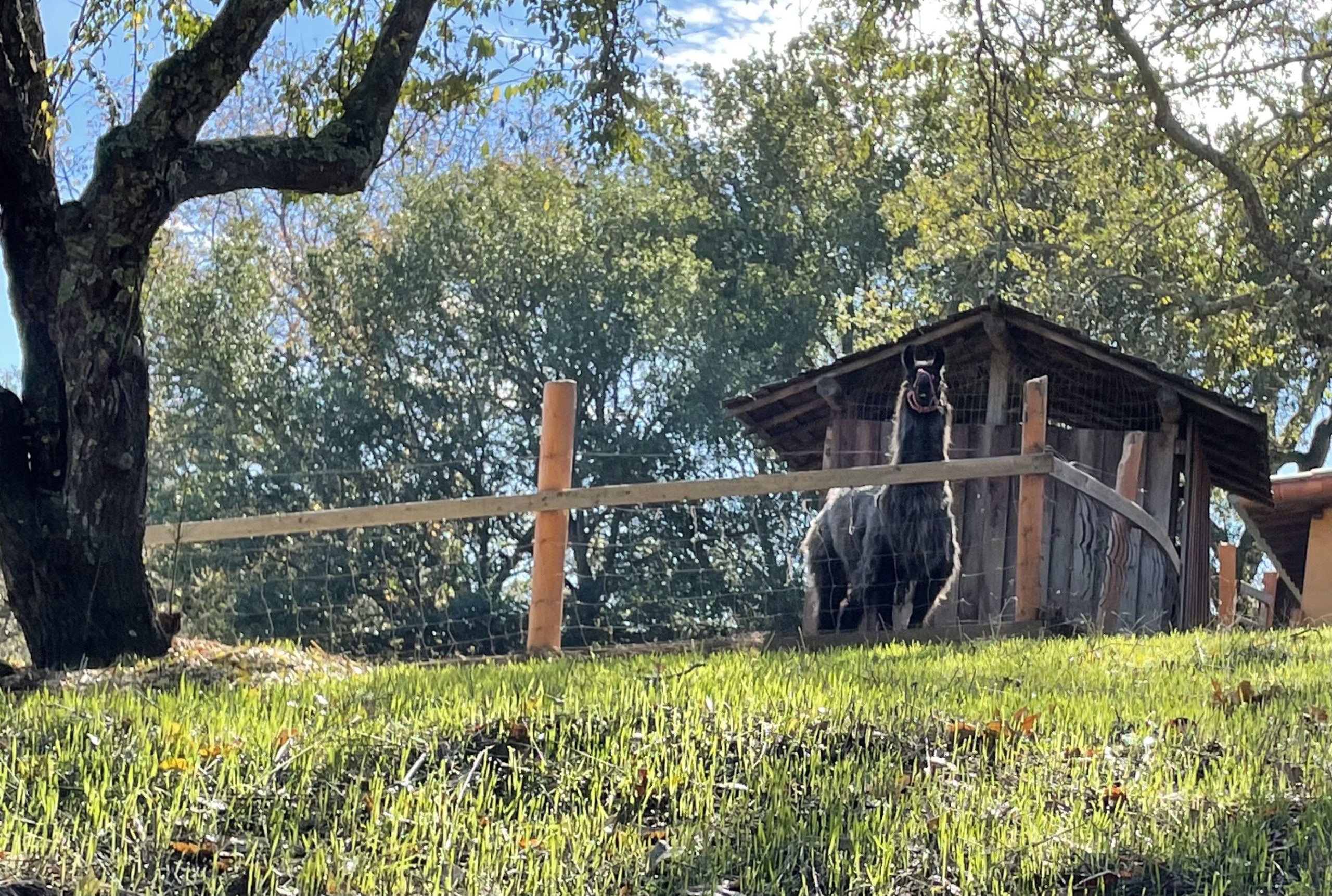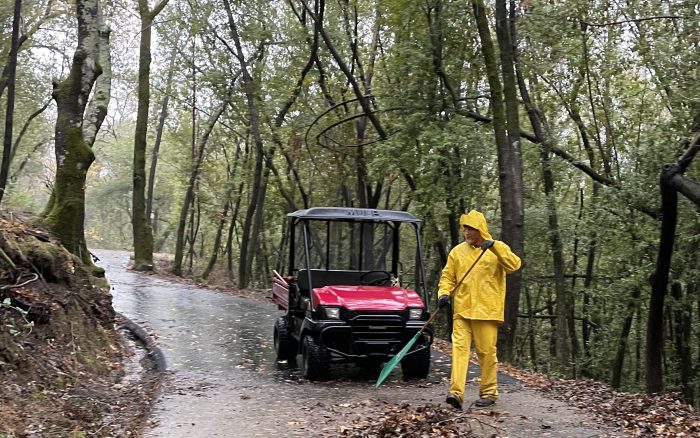It takes two inches of rain to awaken the annual grass seeds in the savanna, and we definitely got two inches of rain last week. It started slowly, with 0.6″ on the first day followed by 1.5″ on the second. I was overjoyed. The dryness of the drought chokes the land. We were all suffering. And it’s increasingly rare to get two inches in October.
And then, the main event– the atmospheric river– began! The next day it started raining in the evening, and it did not stop for the next 36 hours. Each time I turned on the courtyard light in the night, I saw the usually placid mirror of water in the fountain being pelted as if it were boiling. I got the flashlight and ventured outside to read the rain gauge. (I later discovered I could do the same with the new binoculars if there were just a smidgen light.) Each time I emptied the gauge, I was shocked at how quickly we received 1.6″; 2.5″; 1.2″. I recorded each total with the date on a card I keep for each rain year. October 21-22 added up to 11″ —13.1″ if you include the amounts from the first two days. We received more rain in five days than we had the previous rain year of 2020-2021.
I love storms, and this was a doozy. The valley oaks swayed and shook leafy boughs. At times the rain pounded the glass of the western, usually protected, windows and doors. When I rose early Sunday, I waited for the light to walk the road. I wanted to see if the upper pond was filling.
But what quickly became apparent was that I had ignored a more pressing issue. The ditches along the driveway were rushing streams, scouring the stones lining them, which prevented them from being gouged even deeper. But as the water gushed through the ditches, it had washed leaves and branches downhill onto the grated inlets for the culverts, quickly covering them. Driveway gravel covered the leaves a foot deep, making it impossible to see where the drainage should be. As a result, the stream grew angrier and larger, breaching the ditch and erasing the edges of the driveway.
Since the steeper part of the driveway is paved, I had worried less about the impact. In years before we paved it, Donald and Ramon patrolled the driveway at all hours during a storm like this, keeping the inlets clear. I called Casey, and together we dug out the inlets, a demanding job hard on backs. We usually have the ditches raked clean of debris before the rainy season to prevent such an emergency. This was to happen the following Saturday.
Once we dug out the inlets, we proceeded to the upper pond, which was filling rapidly, something it had not done in two years. Satisfied, we decided that, since the electricity was still on, it was a good afternoon for a movie.
But within minutes of Casey’s and the boys’ departure after the movie, I got a call. “Mom, this is a mess. I am going to get tools. Don’t drive. Better walk…” and then exclaimed something that I couldn’t make out. I put on a dry set of rain gear (I went through 3 sets in 24 hours) and walked down our steep driveway past what should have been draining culverts to the spot where the road starts to climb. The deluge of water had carved great gouges eight inches deep in the graveled driveway. It looked like corduroy. At the lowest point, the road had become a river.
We took shovels and rakes once again, climbed to the top, unearthing the inlets to relieve the ditches of excessive flow.
This sounds terrible, I know. It was pouring, we were soaked, and it was getting dark. If Casey were not there, it would have felt awful. But instead, I was oddly peaceful. Water decides where it goes, and you work with it. Casey’s strong shoveling of wet gravel onto the driveway, my raking the debris to the other side, was a rhythm. Each time a vortex of draining water formed and the culvert was again doing its job, we worked our way to the next inlet.
At times like this, I often go into reverie. I was reminded of the Loma Prieta earthquake many years ago. Four of us candidates in training at the San Francisco Jung Institute arrived for classes shortly after the quake and ended up spending the night, flakes of plaster snowing down on us with each aftershock. Someone had a bottle of whisky in her car, and we drank it as we watched fires across the city from the library window and heard screaming in the streets (“The bay bridge has collapsed!) and heard sirens throughout the night. In response to such chaos, we filled five-gallon bottles and every large kettle we could find with water—my rural training, I guess. If the electricity goes off, the well pump does too.
Working with water has a way of calming me, even in what has an edge of catastrophe. I told Casey that the work of digging out the culverts is a dialogue— a dialogue with Earth about this driveway we have cut into her hillside, a dialogue with water, and where water will go. Through this process, I am sensitized to the land in ways that I take for granted most of the time. Jung once wrote, “Nature must not win the game, but she cannot lose. And whenever the conscious mind clings to hard and fast concepts…as is unavoidable… Nature pops up with her inescapable demands.”
Digging out culverts or suffering the consequences during an “atmospheric river” is a quick study of this principle! Perhaps it offers to bring us back in some semblance of balance with natural forces.

Nature’s first green
